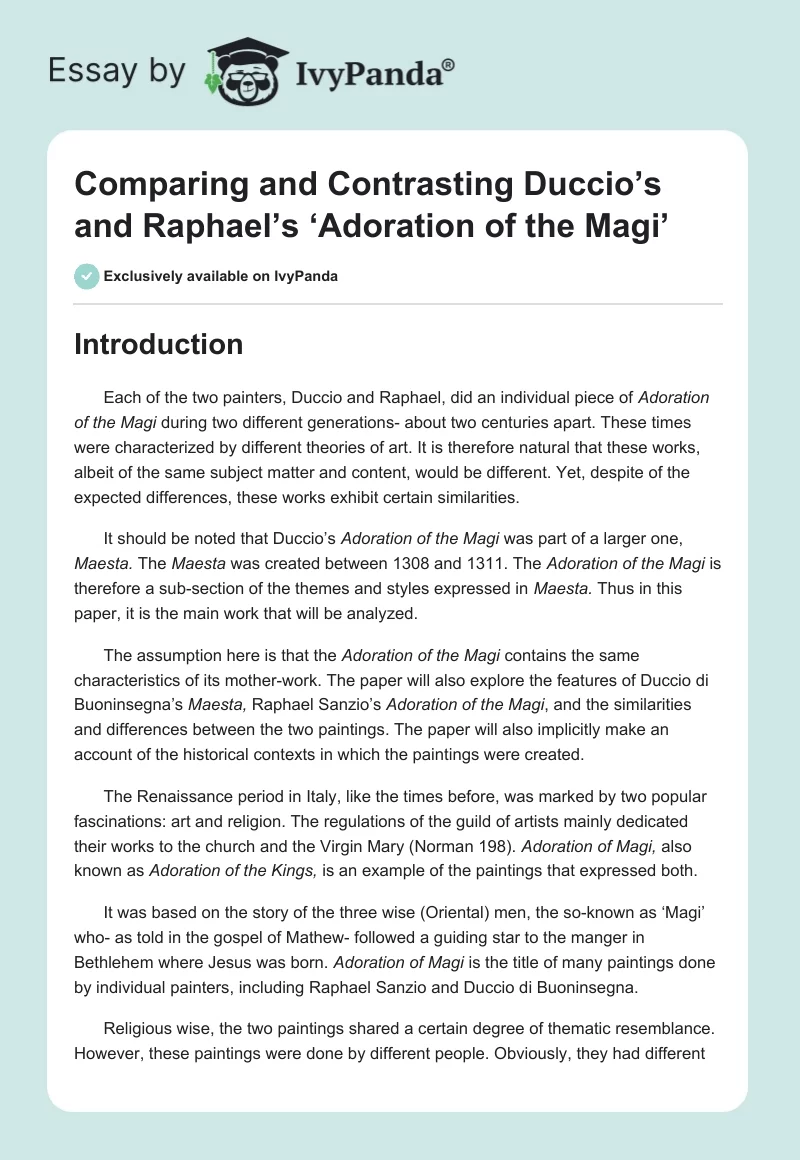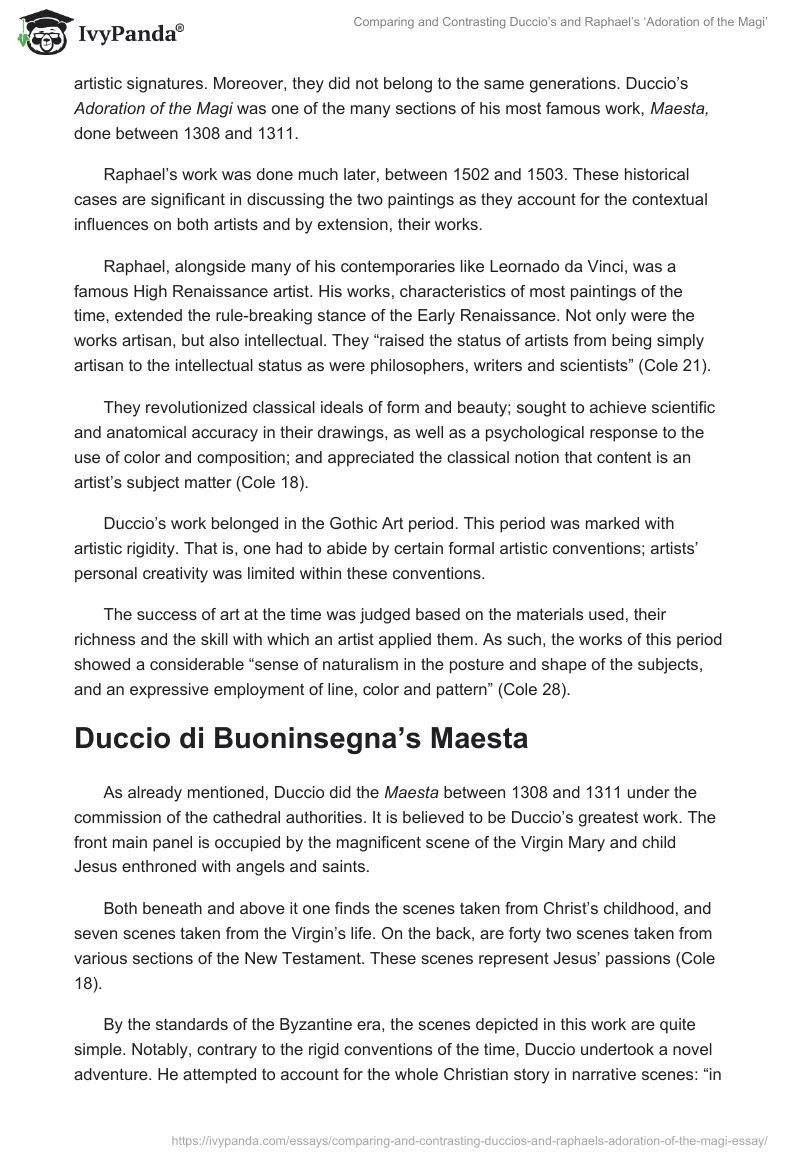Introduction
Each of the two painters, Duccio and Raphael, did an individual piece of Adoration of the Magi during two different generations- about two centuries apart. These times were characterized by different theories of art. It is therefore natural that these works, albeit of the same subject matter and content, would be different. Yet, despite of the expected differences, these works exhibit certain similarities.
It should be noted that Duccio’s Adoration of the Magi was part of a larger one, Maesta. The Maesta was created between 1308 and 1311. The Adoration of the Magi is therefore a sub-section of the themes and styles expressed in Maesta. Thus in this paper, it is the main work that will be analyzed.
The assumption here is that the Adoration of the Magi contains the same characteristics of its mother-work. The paper will also explore the features of Duccio di Buoninsegna’s Maesta, Raphael Sanzio’s Adoration of the Magi, and the similarities and differences between the two paintings. The paper will also implicitly make an account of the historical contexts in which the paintings were created.
The Renaissance period in Italy, like the times before, was marked by two popular fascinations: art and religion. The regulations of the guild of artists mainly dedicated their works to the church and the Virgin Mary (Norman 198). Adoration of Magi, also known as Adoration of the Kings, is an example of the paintings that expressed both.
It was based on the story of the three wise (Oriental) men, the so-known as ‘Magi’ who- as told in the gospel of Mathew- followed a guiding star to the manger in Bethlehem where Jesus was born. Adoration of Magi is the title of many paintings done by individual painters, including Raphael Sanzio and Duccio di Buoninsegna.
Religious wise, the two paintings shared a certain degree of thematic resemblance. However, these paintings were done by different people. Obviously, they had different artistic signatures. Moreover, they did not belong to the same generations. Duccio’s Adoration of the Magi was one of the many sections of his most famous work, Maesta, done between 1308 and 1311.
Raphael’s work was done much later, between 1502 and 1503. These historical cases are significant in discussing the two paintings as they account for the contextual influences on both artists and by extension, their works.
Raphael, alongside many of his contemporaries like Leornado da Vinci, was a famous High Renaissance artist. His works, characteristics of most paintings of the time, extended the rule-breaking stance of the Early Renaissance. Not only were the works artisan, but also intellectual. They “raised the status of artists from being simply artisan to the intellectual status as were philosophers, writers and scientists” (Cole 21).
They revolutionized classical ideals of form and beauty; sought to achieve scientific and anatomical accuracy in their drawings, as well as a psychological response to the use of color and composition; and appreciated the classical notion that content is an artist’s subject matter (Cole 18).
Duccio’s work belonged in the Gothic Art period. This period was marked with artistic rigidity. That is, one had to abide by certain formal artistic conventions; artists’ personal creativity was limited within these conventions.
The success of art at the time was judged based on the materials used, their richness and the skill with which an artist applied them. As such, the works of this period showed a considerable “sense of naturalism in the posture and shape of the subjects, and an expressive employment of line, color and pattern” (Cole 28).
Duccio di Buoninsegna’s Maesta
As already mentioned, Duccio did the Maesta between 1308 and 1311 under the commission of the cathedral authorities. It is believed to be Duccio’s greatest work. The front main panel is occupied by the magnificent scene of the Virgin Mary and child Jesus enthroned with angels and saints.
Both beneath and above it one finds the scenes taken from Christ’s childhood, and seven scenes taken from the Virgin’s life. On the back, are forty two scenes taken from various sections of the New Testament. These scenes represent Jesus’ passions (Cole 18).
By the standards of the Byzantine era, the scenes depicted in this work are quite simple. Notably, contrary to the rigid conventions of the time, Duccio undertook a novel adventure. He attempted to account for the whole Christian story in narrative scenes: “in Maesta, Duccio extended the expressive scope of painted narrative” (Cole 8).). In this effort, Duccio used unique elements of art.
For instance, against the popular tendency of Florence painters to use rounder and more realistic forms, Duccio used a linear decorative style, which employed gold and strong color to create rhythm and pattern. This would be the common style for most fourteenth century Sianese painters.
At the sight of this painting, what strikes one first is its complexity and magnificence. It is about four meters on all sides; painted on both sides and is bright in its glittering gorgeous golden colors. This piece contains within it elements, different styles. The painting has a realistic quality to it, which is likened to that of Giotto Massachio. The overall result is great beauty.
But more than being just a work of art, Maesta was also a revelation of the context in which it was created, including the creator, Duccio. Records on Duccio’s life reveal that he faced legal and social problems. These included fines and suspicions of witchcraft (Cole 26). The art scene of the time was dominated by people of upper classes. Being from a humble background, Duccio did not have much recognition in that circle.
The Maesta was, as discussed above, an unimaginable project. It was not just novel in its size, but in style and content as well. This was believed to be a manifestation of Duccio’s affinity for the unusual. The Maesta was an attempt by Duccio to outdo the other workshops around. In a larger scale, it was also a reflection of a prosperous period following the beating of Florence by Siena at Montaperti.
The Maesta was a reflection of personal and communal hunger for splendor and pomp. But it was not just a secular symbol. It was equally seen as a clear sign of faith and devotion to religion- specifically the church. As such, the Sianese liked the painting as carrying the power of Virgin Mary, seen as the spiritual protector of Siena (Van Os 12).
Raphael Sanzio’s Adoration of the Magi
Raphael was seen as the boy-genius of the Italian High Renaissance. He was unique in his work, which also showed signs of influence from the already available works. For instance, although the style of his work showed traces of Perugino, his work also showed unique forms of modeling, composition and color.
Away from the traditional conventions of art at the time, his subjects were more informal. In order to focus all attention on his characters, Raphael played with light on flesh and fabric, mostly before neutral backgrounds (Van Os 14).
Similarities
These two works, as already seen in part, share certain common features. The most notable similarities between these two works have to do with the materials used- albeit with certain differences. They also share the exploration of the same subject matter. This is portrayed through their religious content, but this is not all. Both artists used wood as the basic material for their works.
This may partly be because wood is generally available and cheap. Also, there are many varieties of wood from which one may choose. But while Duccio’s painting is done with egg-tempera on wood, Raphael’s is oil on wood.
Duccio’s use of wood is perhaps inspired by the need to attempt a new challenge at a time when the material used constituted an important part of one being judged as artistically successful. As seen above, this project was an ambitious move by Duccio to make a record. The choice of material, and the size of it, may generally have been part of that ambition.
The most visual similarity is the use of color in both works. Both artists used bright colors to bring out rhythm and pattern. Both works also seem to take on the same theme, under the same subject matter, religion. It is largely evident that the Italian paintings in these two periods focused on religion. The painters in the Gothic period used their works to express their devotions and faith to the Christianity and the church.
But the High Renaissance painters, while focused their works on religion, did not necessarily deal with Christian themes, and sometimes when they did, they did not necessarily express their devotions. Some, like Leornado da Vinci, questioned certain beliefs and practices of the church (such as the presentation of the human body), or explored other religions besides Christianity (Van Os 12).
Differences
Although the two painters use the same basic material, wood, Duccio uses egg-tempera and Raphael uses oil. Egg-tempera has a low binding ability. It needs a well-absorbing surface if there’s need for durability of the painting.
This may have been the reason why Duccio picked on wood as his basic material. There are certain woods that have as good absorbing ability. This combination may be the reason Duccio’s work has survived many years.
There are other visible differences that expose the styles of the times. Duccio’s work achieves magnificence in size, color, composition, rhythm and pattern among others.
But it lacks in detail. In comparison, Raphael’s work achieves success in detail. Renaissance paintings, unlike those done in the Gothic times, emphasized on details and depth (of human body, of the three-dimensionality of figures, shadowing and so on).
On theme, Duccio, to a certain degree, makes his devotion to faith in the church obvious. He is set out to make a timeless statement on the place of the church in his own heart and that of the people of Siena. Raphael does not. Raphael seems to have merely done what he was commissioned to do. He does not necessarily make his attachment to the church- if any- obvious.
Conclusion
Generally, the similarities between the two works have to do with the relatively short time-lapse between the two periods in which they were created. For instance, there was a seemingly little understanding on how to present the human body.
This may have been because the church saw any such attempts as sin. The differences in theme for instance, can partly be attributed to a relatively “dwindling power of the church” (Van Os 18). People were growing more and more self-aware. Da Vinci was the first to attempt accurate presentation of the human body, much to the chagrin of the church.
Works Cited
Cole, Bruce. Sienese Painting in the Age of the Renaissance. Bloomington: Indiana University Press, 1985. Print.
Norman, Diana. Art Society and Religion. New York: Harper & Row, 1995. Print.
Van Os, Henk. Sienese Altarpieces, 1215-1460. Groningen: Egbert Forsten Publishing, 1990. Print.


